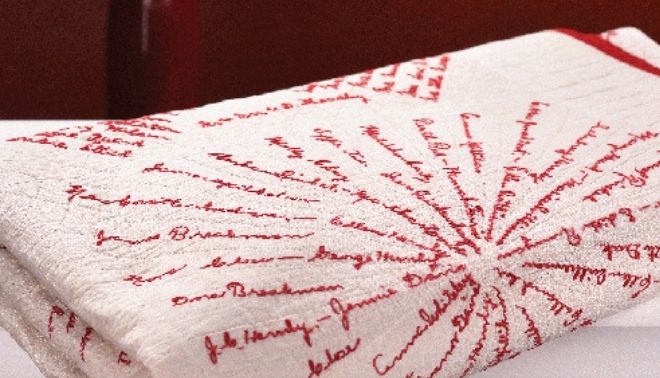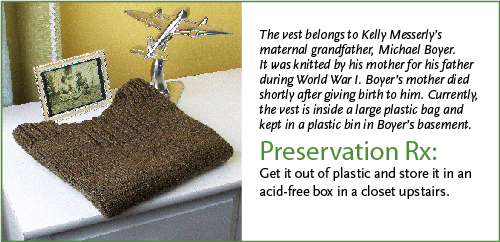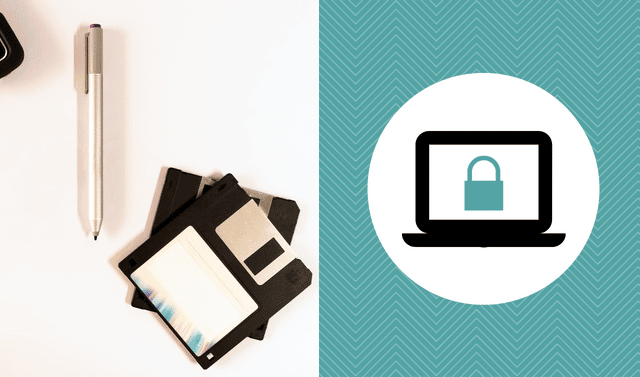
Medical students learn from day one that first and foremost, doctors should do no harm. Back in our ancestors’ day, however, certain treatments epitomized the saying, “sometimes the cure is worse than the ill.” (Bloodletting, anyone?) Likewise, when it comes to preserving your heirlooms, the family historian’s Hippocratic oath is “do nothing you can’t undo.” On the surface, this seems simple enough: You don’t amputate a page of the family Bible because it’s dirty.
But proper preservation techniques aren’t always so obvious. In fact, the people who inherit cherished family keepsakes—out of ignorance or misinformation—sometimes follow “remedies” that ultimately do more harm than good: Laminating a birth certificate. Tearing a photo out of an old scrapbook. Putting Dad’s childhood stuffed dog through the washing machine.
To ensure that your family heirlooms meet a happier fate than poor Fluffy did, we’ve outlined safe, tested prescriptions for preserving 10 common kinds of family heirlooms. If you possess a keepsake that doesn’t fit neatly into these categories, use the tips prescribed for items of the same material (paper, wood, cloth, metal)—and see the American Institute for Conservation of Historic and Artistic Works’ Web site to find advice and professional conservators to consult.
Paper documents
Likely the most common heirloom, paper, is also the most at-risk. Just where are your grandparents’ original birth certificates? Stuffed in a cardboard box in the basement? Code blue!
Doctor’s orders: Protect paper from light, moisture and heat, and always wash your hands before handling delicate documents. Never eat or drink around original documents, and don’t fold, staple, tape, paperclip or laminate them. (Make copies of the originals, and then you can go crazy with the Swingline.) Carefully wipe away any dirt with a soft brush.
Keep the documents unfolded in archival folders or envelopes made of Mylar or acid- and lignin-free paper. Store those in a flat file or manuscript box. You should always transcribe the information electronically to preserve the data. Scan or photograph the documents and make copies on acid-free paper; store those as you would the originals.
Keeping extra sets of copies with other people is also a good backup.
Newspapers
Let’s face it, newspapers weren’t made to last. Wood-pulp paper deteriorates quicker than the value of a hedge fund. The good news: Older clippings may be in better shape than the story about your 4-H project in a 1965 edition of the Daily Herald. Before the mid-1800s, newsprint was made of higher-quality, longer-lasting cotton rag paper.
Doctor’s orders: As with paper documents, you need to protect newspapers and clippings from light, moisture and heat. Remove staples if you can do so without tearing the paper. Has your clipping been laminated? You can’t undo lamination—which is why preservation professionals recommend against it—so your best bet is to transcribe the article and scan it or make photocopies.
Keep clippings unfolded and separate in acid-free folders between sheets of buffered paper. Polyester sleeves are good for fragile clippings. Store whole newspapers unfolded and flat in archival boxes.
Books and Bibles
These tomes likely hold captivating information about your ancestors. Bibles often contain family dates and names difficult to come by elsewhere—in fact, they’re sometimes the only source of vital statistics for ancestors who predated official vital records.
Doctor’s orders: Many of the same rules for paper apply to bound books. Avoid exposing the tomes to heat, light and moisture. If a book’s dusty, use a soft cloth to gently brush dirt off the covers. Hold the book together tightly when dusting the edges to avoid pushing dirt in between pages. You should remove rubber bands, metal fasteners and paper clips that can corrode the paper, but don’t attempt any DIY bookbinding.
If the cover or inside pages are loose, use unbleached cotton tape to tie the book together. Wrap it in buffered tissue paper and keep in a custom-fit archival box if it’s fragile. Store the book flat or fully supported if you’re storing it upright on a shelf.
Transcribe the information the book contains. You shouldn’t force a fragile book open to scan it—instead, photograph pages while the book rests on a nonslip surface.
Scrapbooks and photo albums
Looking at intact collections of photographs and ephemera is like putting a stethoscope to your ancestor’s heart. But black pages and outmoded binding materials can cause preservation headaches.
Doctor’s orders: Generally, you should leave scrapbooks intact. But if an item poses a hazard to the rest of the book, remove it carefully and store it in a separate container. Insert sheets of acid-free tissue between the pages to buffer the items. Keep the book in an archival box slightly larger than it and pad with tissue paper. If the glue has dried out or is minimal, use a microspatula to gently remove photos from an acidic album and preserve them properly. But don’t freeze the pages, soak them in water or apply solvents to remove snapshots.
Photographing or scanning the scrapbook or album before you remove anything is essential. Consider making an online photo album dedicated to the scrapbook or album to preserve its memory.
Photographs and tintypes
It’s hard to imagine, in this age of paparazzi and camera phones, that it was a big deal for our ancestors to get their picture taken. But aren’t you glad they did? Here’s how to preserve those pre-Kodak moments.
Doctor’s orders: Avoid exposing photgraphs to bright light, and protect the shots from oil and dirt on your hands. You should handle photos only at the edges, and don white cotton gloves if you’ll be touching a lot of them.
Clean them carefully with a soft, dry brush—don’t use water or solvents, and don’t attempt to repair a torn or flaking photo yourself. A professional conservator might be able to remove the tarnish from tintypes and daguerreotypes (old photographs created on metal).
If possible, remove photos from acidic or self-adhesive (also called “magnetic”) albums. Keep photo prints in acid-free paper or polyester (Mylar) envelopes, albums or folders. Store daguerreotypes flat in a clamshell box. Keep tintypes in acid-free paper or polyester folders. Photos should reside in a low humidity environment with a temperature around 68 degrees Fahrenheit.
Scan the photos to make copies to share—never pass around your originals at the family reunion. (Coleslaw and keepsakes just don’t mix.) Store your digital scans online for extra backup. Display prints behind UV-filtering glass with acid-free mats.
Jewelry
Diamonds are a girl’s best friend, sure, but they’re even better when they were Great-grandma’s. If you’ve got jewels with a pedigree, take care of them with these pointers.
Doctor’s orders: Never use toothpaste, bleach or other abrasives to clean jewelry. Your course of action depends on the piece’s makeup. With silver, you should use a soft cotton cloth and silver polish. For gold pieces, use a soft toothbrush to clean them, or try warm water and mild soap if they’re especially soiled. Use only warm water and mild soap for gemstones.
Make sure the jewelry is completely dry before storing it in a satin- or velvet-lined box with compartments. Wrap silver in tissue paper or silver cloth bags to reduce tarnish. Store diamond pieces separately to avoid scratching softer jewelry. Wrap soft stones, such as opals, amber and pearls, in acid-free tissue paper.

Dolls and toys
If Teddy’s seen better days, the toy soldiers are going AWOL and the dolls have racked up some impressive hospital bills, it’s time to re-evaluate your course of treatment.
Doctor’s orders: Dolls of a certain age were made of porcelain, wood, wax, plastic, papier-mâché or rags. If Polly’s dirty, use a soft brush to gently dust her, or use a cotton swab with distilled water (except on fabric or paper-based dolls). Never use solvents. Follow the clothing guidelines below to take care of her outfits, and inspect her clothes and hair for insects and eggs to avoid an infestation. Store your dolls in archival boxes with tissue paper, and keep dolls with movable eyes face down so the mechanisms don’t fall back into the head.
Dust stuffed toys with a soft brush, or vacuum them with a brush attachment covered in cheesecloth. Never use water. Store Teddy in an archival box with acid-free tissue paper—not in plastic or with mothballs.
To keep plastic toys clean, use distilled water on a clean sponge—no solvents allowed. Store the toys in ventilated boxes in a cool, dry place. Plastic leeches gas as it decomposes, which can harm other items.
Handle metal toys with cotton gloves; the oil from your hands can cause corrosion. Don’t try to clean painted playthings, such as old metal cars. Store the pieces in polyethylene bags with a silica gel packet, and display them on glass rather than wood shelves. Dolls and toys should be kept in closed cabinets with metal or glass shelves, away from direct sunlight.
Clothing
Christening gowns, military uniforms, wedding dresses … Many important events in our ancestors’ lives had outfits to match. Keep their duds in shape with this advice.
Doctor’s orders: Fragile antique clothing shouldn’t be washed, dry-cleaned or bleached—consult a conservator about any cleaning you think should be done. If the pieces are occasionally worn, avoid exposing them to makeup and antiperspirants. If your garment’s not in great shape, think twice before loaning it out. Even the oil from your fingers can cause deterioration of the fibers, so it’s best to wear white cotton gloves while handling the clothing.
Fabric is especially sensitive to light and humidity, so if you display your heirloom clothing, do so only in a dimly lit room. If you hang it for display, use a plastic hanger padded with unbleached cotton. But you shouldn’t hang fragile, knit or heavy garments that could rip or stretch out. Your best option for storing these items is in large acid-free boxes with tissue or muslin stuffing to help the clothing retain its shape. Don’t use mothballs; inspect visually for insects.

Quilts and needlework
Hand-sewn pieces often include interesting bits of information about your ancestors’ lives. So follow these tips to save that sampler, keep that quilt and defend that doily.
Doctor’s orders: Feel free to wash a modern, machine-sewn quilt, but consult a professional before cleaning a quilt that’s more than 50 years old or one that has hand-lettering or contains silk, wool or velvet.
Often, airing out your quilt on an overcast day will remove most of the odors and dirt. You can also use a soft brush attachment to vacuum off dirt if there are no beads or fragile parts.
Wrap your heirloom quilt in washed, unbleached muslin or fold it in a pillowcase before storing it in an acid-free box. Never use a cardboard box or plastic bag or store it in a wooden drawer, unless the wood has been treated with a sealant. Refold the quilt a few times a year to avoid permanent creases—these can speed the breakdown of the fibers.
You should store needlework flat in an acid-free container with tissue paper, or frame it in a shadowbox so glass doesn’t touch the fabric. The best way to store and display a quilt is by laying it out on an unused bed—just make sure to keep Fido and Fluffy out of the patient’s room. Never nail a quilt directly to the wall. Instead, loosely sew on fabric strips that you can then hang on a rod. Hang the quilt only for a short time to minimize stress on the fabric.

Flags
A flag passed down from a veteran in the family inspires pride in your country—and in your family—but fight your urge to fly it.
Doctor’s orders: Those colors can run if you try washing the flag yourself, so it’s best to consult a professional conservator about cleaning options. Your main concern should be to protect the flag from light, moisture, dirt and insects. You can extend the fabric’s lifespan by keeping it in an acid-free, triangular flag box. (Though you shouldn’t fly the flag, the supply companies listed in the box at left do sell flag boxes with windows for display. Just be sure to keep it out of direct sunlight.) Interleave the fabric with tissue paper, or use unbleached cotton if you live in a desert climate. In a tropical climate, you could use a tin container with a silica gel packet enclosed to trap moisture. It’s worth looking into pre-emptive preservation options even if your keepsakes barely qualify as vintage. (Someday, someone will cherish your “Mork & Mindy” lunchbox.) Avoiding worst-case heirloom scenarios should be your No. 1 concern—after all, prevention is the best medicine.

Heirloom Health Insurance Do
- Wash your hands (and skip the lotion) before handling an heirloom.
- Keep the heirloom away from direct sunlight, extreme cold and heat, moisture, dirt and insects.
- Store heirlooms in archival, acid-free and appropriately sized containers.
- Clean items before storing them, but only if you can do so safely.
- Photograph heirlooms to create a visual record in case of disaster or loss.Consult an expert before attempting any major repairs or treatments.
Heirloom Health Insurance Don’t
- Do anything you can’t undo.
- Let anyone with dirty hands touch the heirlooms.
- Stuff your heirlooms in a cardboard box or wooden chest.
- Pass originals around at the reunion.
- Store heirlooms in the attic or the basement.
- Forget to record each heirloom’s stories and provenance.
Toolkit
- Archival Methods, (866) 877-7050
- Caring for Your Family Treasures: A Concise Guide to Caring for Your Cherished Belongings by Jane S. and Richard W. Long (Harry N. Abrams)
- Gaylord Brothers, (800) 962-9580
- Hollinger Metal Edge, (800) 634-0491
- Light Impressions, (800) 828-6216
- Saving Stuff: How to Care for and Preserve Your Collectibles, Heirlooms, and Other Prized Possessions by Don Williams and Louisa Jaggar (Fireside)
- University Products, (800) 628-1912
A version of this article appeared in the December 2009 issue of Family Tree Magazine




